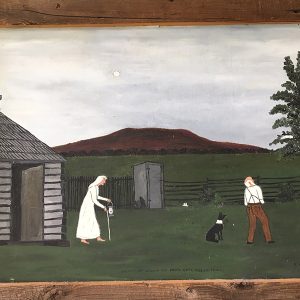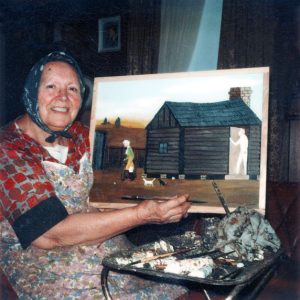calsfoundation@cals.org
Essie Ann Treat Ward (1902–1981)
Essie Ann Treat Ward, who is often referred to as “Grandma Moses of the Ozarks,” produced paintings that are fascinating examples of primitive art, a style of folk painting. From a field of one hundred and fifty folk painters, she was chosen one of the top ten in Arkansas, receiving recognition and appreciation in her native region and state. In 1970, she participated in the Smithsonian Festival of American Folklife in Washington DC. Today hundreds of her paintings in the Miranda and Hezzakiah series hang in public and private art collections around the world.
Essie Treat was born on October 20, 1902, to Henry and Parthenia Treat in the community of Nubbin Hill (Searcy County). Her father was a farmer and her mother a homemaker, and she had numerous brothers and sisters. She attended school at Nubbin Hill through the eighth grade and, at the request of a teacher, drew patriotic scenes on the walls of the school.
Early in life, she began creating drawings, toys, and sculptures. In 1922, she married Jesse Carroll Ward. On a small farm near Marshall (Searcy County) they raised seven children, earning a living by growing vegetable gardens, fruit trees, chickens, and pigs. In 1959, Ward was diagnosed with cancer, so she put down the plow and picked up a paint brush. She had been painting since she was a little girl and, during this period of enforced idleness, grew more serious about marketing her work. Without the benefit of formal training, she began to capture aspects of Arkansas’s early rural lifestyle.
Her scenes, featuring a pioneer couple known as Miranda and Hezzakiah, and including a cast of characters such as farm animals and wildlife, proved so popular that orders came in faster than she could fill them. Her inspiration to create the couple came when she was commissioned to reproduce a photograph of a woman with a churn in the doorway of a log cabin. Later, someone asked her to include a man in the picture. Although each painting is original, she developed a series of fifty-five different scenes depicting the couple involved in rural life, complete with landscapes shaded correctly for the time of year. A white mule, chickens, ducks, a black cat, a paling fence, a log cabin, an outhouse with quarter moon cutout, primitive farm equipment, and flower beds were also included in her paintings.
Sometimes humorous and sometimes poignant, the pictures are detailed histories of a simple way of life. She utilized her memories and native humor to create scenes in which her fictional characters held center stage. These were her most sought after works, but she also painted wildlife and landscapes, including areas along the Buffalo River. At home in the quiet of the mountains on every day except Sundays, she usually finished one picture a day. Sitting in a hickory-bottomed chair, using oil straight from the tube, she painted on masonite while holding the board on her lap. Her trademark, two white marks that resemble rabbit ears, appears in every painting. As her fame grew, the trademark became important to people who collected her work.
Ward died on July 23, 1981, leaving her contribution to folk art in the form of a pictorial history of Arkansas mountain life. She is buried in Canaan Cemetery in Searcy County. Fifty-five of her paintings are now owned by Shiloh Museum of Ozark History in Springdale (Washington and Benton counties), forty of which were collected by Jeanne Hoffer-Tucker. This is believed to be the largest and most complete collection of her work.
For additional information:
Deane, Ernie. “Ward Paintings to be Shown in Shiloh Museum.” Marshall Mountain Wave, September 30, 1982, p. 1.
“Grandmother Paints Ozark Couple.” Grit, February 7, 1971, p. 18.
Poole, Jerry D. “An Historical and Biographical Study of Ten Arkansas Folk Painters during the Decade 1960–70.” PhD diss., University of Arkansas at Fayetteville, 1974.
Shiloh Museum of Ozark History. Springdale, Arkansas. https://shilohmuseum.org/ (accessed December 6, 2023).
Jeanie Horn
Marshall, Arkansas
 Arts, Culture, and Entertainment
Arts, Culture, and Entertainment Early Twentieth Century, 1901 through 1940
Early Twentieth Century, 1901 through 1940 Folklore and Folklife
Folklore and Folklife Essie Ward Painting
Essie Ward Painting  Essie Ann Ward
Essie Ann Ward 




Comments
No comments on this entry yet.